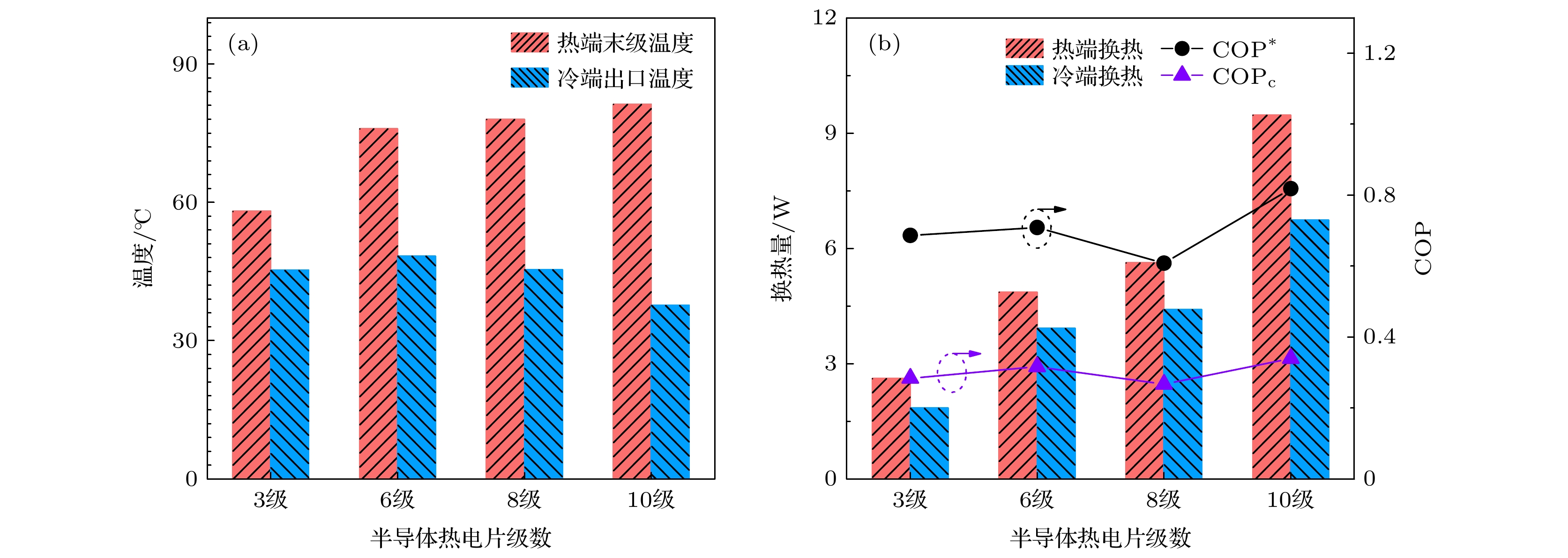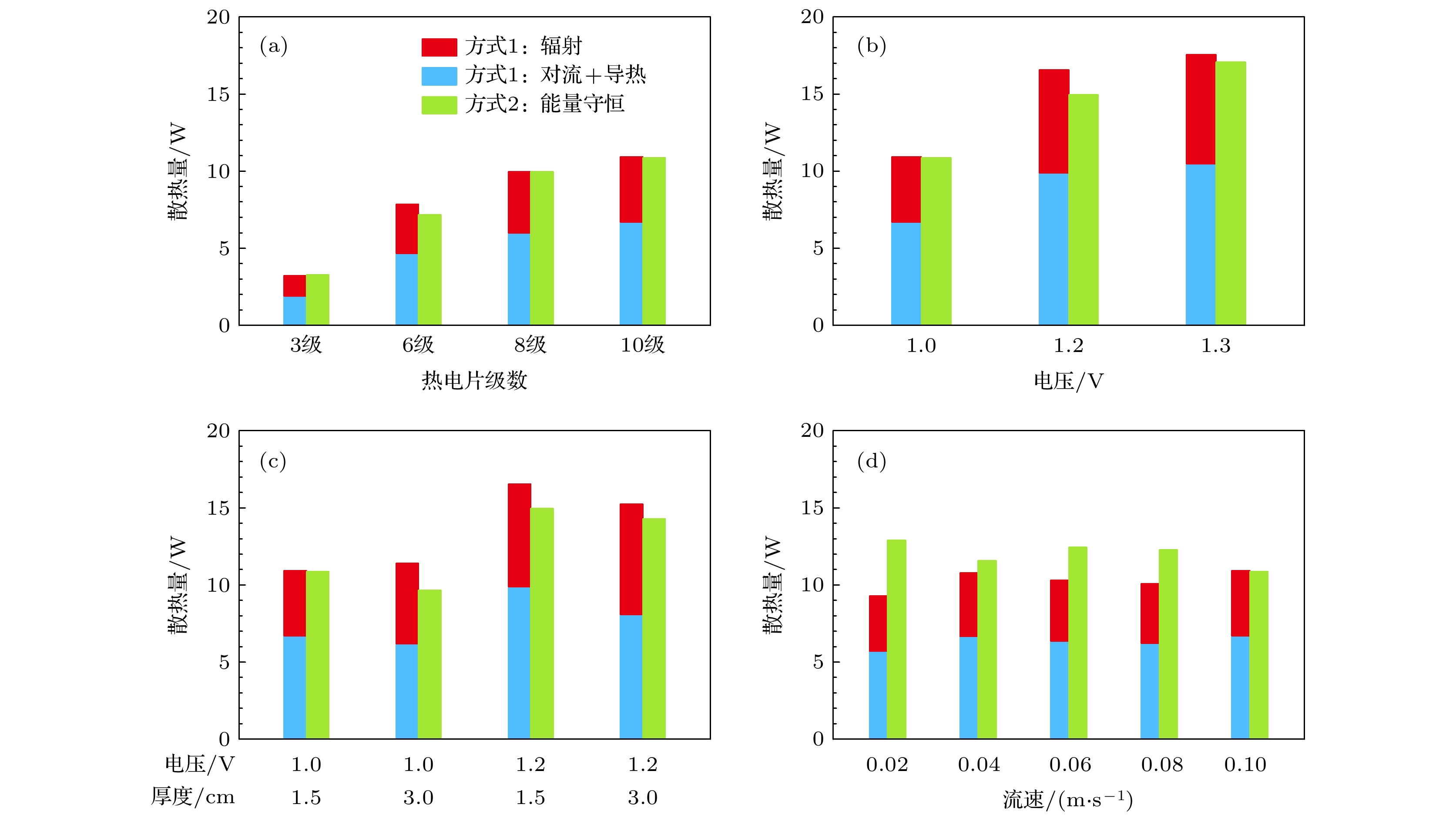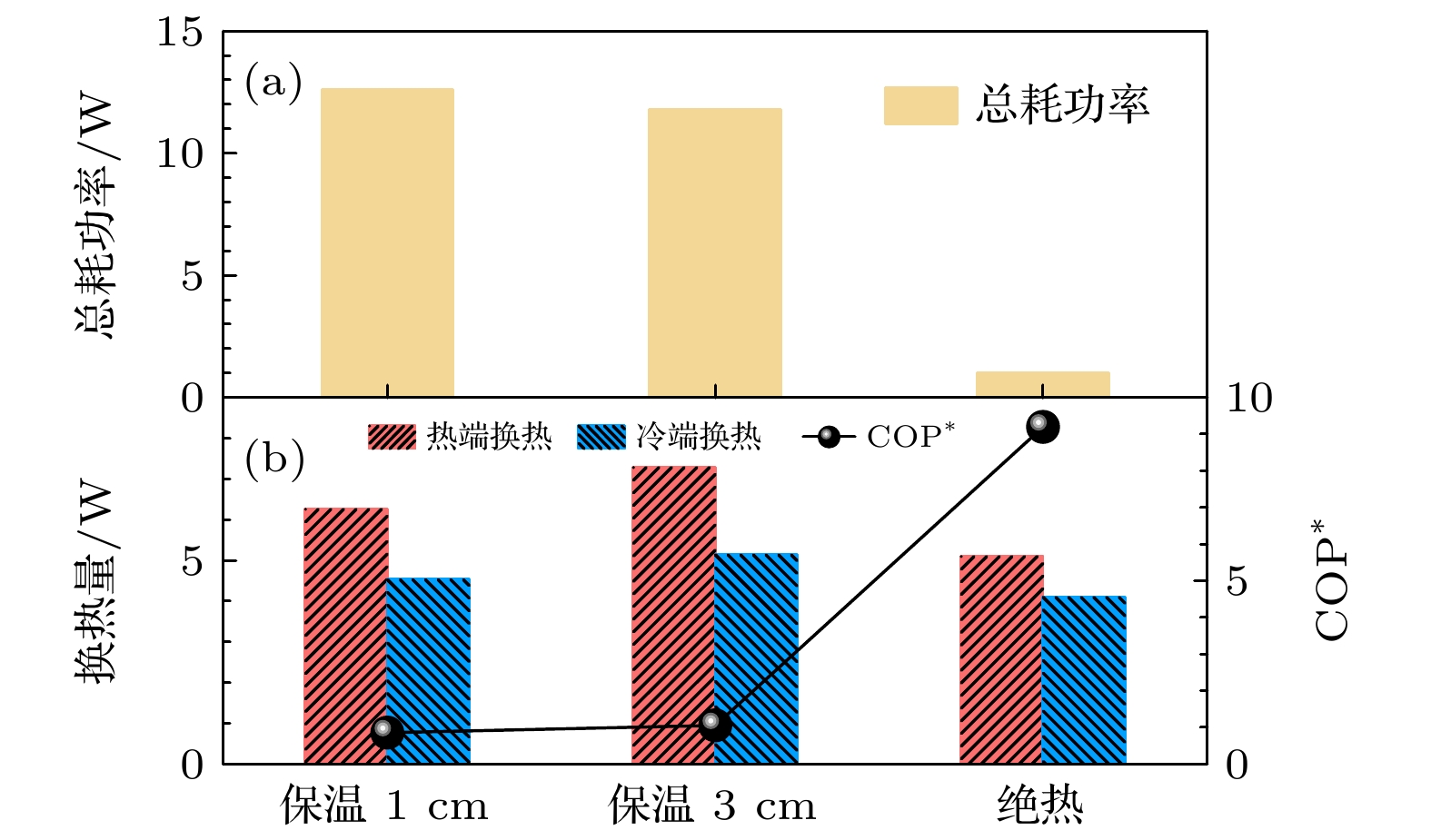-
流行性病毒严重影响着人类健康和社会正常运行, 因此有效杀灭病毒变得尤为重要。 本文对热电空气消毒系统的传热性能进行研究, 该系统利用半导体热片具有冷热两端的特点, 可以实现对空气加热(可用于消毒)与冷却降温至舒适温度. 测量结果显示流入系统的空气首先被升至80 ℃进行消毒, 之后被冷却降温至35 ℃. 该系统总的能量利用率最高可达1.2. 此外, 结合测量结果和数值计算, 本文分析了热电片级数、输入功率、空气流量以及边界保温等参数对系统传热性能和能量利用率的影响. 该系统在公共卫生、医疗、和家庭等空气消毒领域具有应用潜力.实际消毒效果需要结合医学应用进一步研究.Epidemic viruses seriously affect human health and the normal operation of society, so it is particularly important to effectively kill viruses. In this work, the thermal performance of a thermoelectric air disinfection system are studied. Utilizing the characteristics of semiconductor thermoelectric sheets with both cold and hot ends, the system can increase the air temperature by heating (cound be used in sterilization), and then, reduce the temperature of the air by cooling. The measurement results show that the air temperature can be increased to 80 ℃ first, and then cooled to 35 ℃. The total energy utilization rate of the system can reach up to 1.2. In addition, combined with the measurement results and numerical calculations, the parameters such as the number of thermoelectric element series, input power, air flow, and boundary insulation can be used to analyze their effects on the system performance. The system may have broad potential applications in public health, medical care, and household disinfection.
-
Keywords:
- semiconductor thermoelectricity /
- air disinfection /
- COP* /
- COVID-19
[1] Baize S, Pannetier D, Oestereich L, Rieger T, Koivogui L, Magassouba N F, Soropogui B, Sow M S, Keïta S, De Clerck H 2014 N. Engl. J. Med. 371 1418
 Google Scholar
Google Scholar
[2] Feldmann H, Geisbert T W 2011 The Lancet 377 849
 Google Scholar
Google Scholar
[3] Chidlow G, Harnett G, Williams S, Levy A, Speers D, Smith D W 2010 J. Clin. Microbiol. 48 862
 Google Scholar
Google Scholar
[4] Hurt A C, Ernest J, Deng Y M, Iannello P, Besselaar T G, Birch C, Buchy P, Chittaganpitch M, Chiu S C, Dwyer D 2009 Antiviral Res. 83 90
 Google Scholar
Google Scholar
[5] Ferguson N M, Keeling M J, John Edmunds W, Gani R, Grenfell B T, Anderson R M, Leach S 2003 Nature 425 681
 Google Scholar
Google Scholar
[6] Gani R, Leach S 2001 Nature 414 748
 Google Scholar
Google Scholar
[7] Control C F D 2011 MMWR Morb. Mortal. Wkly. Rep. 60 1618
[8] Douek D C, Brenchley J M, Betts M R, Ambrozak D R, Hill B J, Okamoto Y, Casazza J P, Kuruppu J, Kunstman K, Wolinsky S 2002 Nature 417 95
 Google Scholar
Google Scholar
[9] Stadler K, Masignani V, Eickmann M, Becker S, Abrignani S, Klenk H-D, Rappuoli R 2003 Nat. Rev. Microbiol. 1 209
 Google Scholar
Google Scholar
[10] Fouchier R A, Kuiken T, Schutten M, et al. 2003 Nature 423 240
 Google Scholar
Google Scholar
[11] Prather K A, Wang C C, Schooley R T 2020 Science 368 1422
 Google Scholar
Google Scholar
[12] Chen N, Zhou M, Dong X, Qu J, Gong F, Han Y, Qiu Y, Wang J, Liu Y, Wei Y 2020 The Lancet 395 507
 Google Scholar
Google Scholar
[13] World Health Organization. Coronavirus disease (COVID-19)https://www.who.int/emergencies/diseases/novel-coronavirus-2019 [2022-02-20]
[14] 疫情监测 https://coronavirus.app [2022-02-20]
https://coronavirus.app [2022-02-20]
[15] 刘洋, 谢珊珊, 杨凯, 曹巧玲, 田葆萍, 王木根 2017 职业与健康 33 1422
Liu Y, Xie S S, Yang K, Cao Q L, Tian B P, Wang M G 2017 Occupat. Health 33 1422
[16] Boo Y C 2020 Antioxidants 9 637
 Google Scholar
Google Scholar
[17] Narayanan D L, Saladi R N, Fox J L 2010 Int. J. Dermatol. 49 978
 Google Scholar
Google Scholar
[18] Yap T F, Liu Z, Shveda R A, Preston D J 2020 Appl. Phys. Lett. 117 060601
 Google Scholar
Google Scholar
[19] Burton J, Love H, Richards K, Burton C, Summers S, Pitman J, Easterbrook L, Davies K, Spencer P, Killip M 2021 J. Virol. Methods 290 114087
 Google Scholar
Google Scholar
[20] Wang T T, Lien C Z, Liu S, Selvaraj P 2020 MedRxiv 10.1101/2020.04. 29.20085498 [Physics]
[21] Pastorino B, Touret F, Gilles M, de Lamballerie X, Charrel R N 2020 BioRxiv 10.3390/v12060624 [physics]
[22] Chin A W, Chu J T, Perera M R, Hui K P, Yen H-L, Chan M C, Peiris M, Poon L L 2020 The Lancet Microbe 1 e10
 Google Scholar
Google Scholar
[23] Pratelli A 2008 Vet. J. 177 71
 Google Scholar
Google Scholar
[24] Darnell M E, Subbarao K, Feinstone S M, Taylor D R 2004 J. Virol. Methods 121 85
 Google Scholar
Google Scholar
[25] Charm S E, Landau S, Williams B, Horowitz B, Prince A M, Pascual D 1992 Vox Sang. 62 12
 Google Scholar
Google Scholar
[26] Trancossi M, Carli C, Cannistraro G, Pascoa J, Sharma S 2021 Int. J. Heat Mass Transf. 170 120983
 Google Scholar
Google Scholar
[27] Yu L, Peel G K, Cheema F H, Lawrence W S, Bukreyeva N, Jinks C W, Peel J E, Peterson J W, Paessler S, Hourani M 2020 Mater. Today Phys. 15 100249
 Google Scholar
Google Scholar
[28] Correia G, Rodrigues L, Da Silva M G, Gonçalves T 2020 Med. Hypotheses 141 109781
 Google Scholar
Google Scholar
[29] Rezaei N, Jafari M, Nazari A, Salehi S, Talati F, Torab R, Nejad-Rahim R 2020 AIP Adv. 10 085308
 Google Scholar
Google Scholar
[30] Shan X, Zhang H, Liu C, Yu L, Di Y, Zhang X, Dong L, Gan Z 2020 ACS Appl. Mater. Interfaces 12 56579
 Google Scholar
Google Scholar
[31] Ji R, Pan T, Peng G, Ma J, Yang N, Hao Q 2021 Mater. Today Phys. 19 100430
 Google Scholar
Google Scholar
[32] Simons R, Ellsworth M, Chu R 2005 J. Heat Transfer 127 76
 Google Scholar
Google Scholar
[33] Han J, Park J S, Lei C 1985 J. Eng. Gas Turbines Power 107 628
 Google Scholar
Google Scholar
[34] Han J, Park J S 1988 Int. J. Heat Mass Transf. 31 183
 Google Scholar
Google Scholar
[35] Yang N, Hao Q, Ji R C 2021 Chinese Patent CN 214 746 278 U(in Chinese)[杨诺, 郝馨, 季仁才 2021 中国专利 CN 214 746 278 U]
[36] Yang N, Hao Q, Ji R C Wang Y P Li Z W 2021 Chinese Patent CN 119 211 14 B(in Chinese)[杨诺, 郝磬, 季仁才, 王云鹏, 李忠炜 2021 Patent CN111921114 B]
[37] 杨诺, 郝磬, 季仁才, 定志东 2021 Patent CN112089882 B
Yang N, Hao Q, Ji R C Ding Z D 2021 Chinese Patent CN 112 089 882 B (in Chinese)
-
图 2 实验搭建测量平台实物图 (a)单个半导体制冷片和换热片单元; (b)多级半导体热电片组成通道; (c)测量过程实物图; (d)加厚保温层后测量实物图
Fig. 2. Physical diagram of the measurement platform built in the experiment: (a) A single semiconductor refrigeration element and heat exchange element unit; (b) the multi-stage semiconductor thermoelectric element constitutes a channel; (c) the physical diagram of the measurement process; (d) the physical diagram of the measurement after adding the insulation layer.
图 4 不同功率下实验测试和计算结果 (a)电压1.3 V时不同位置的空气温度测试和计算; (b)不同功率下计算的温度云图; (c)不同功率下的温度比较; (d)不同功率下的换热量和性能系数
Fig. 4. Experimental test and calculation results under different input powers. (a) Temperature measurement and calculation at different positions when the voltage is 1.3 V; (b) cloud diagram of temperature under different power; (c) comparison of temperature under different power; (d) heat exchange and COP under different power.
图 6 (a)流量为7.52 L/min温度测试和计算; (b)不同空气流量下的温度云图; (c)不同空气流量下的温度; (d)不同空气流量下的换热量和COP*
Fig. 6. (a) Temperature test and calculation with a flow rate of 7.52 L/min; (b) temperature cloud diagram under different air flow rates; (c) temperature under different air flow rates; (d) heat exchange and COP* under different air flow rates.
图 7 (a)流量为8.91 L/min温度测试和计算; (b)保温层加厚前后的温度云图; (c)不同工况下加厚保温层前后的温度对比; (d)不同工况下加厚保温层前后的COP*对比.
Fig. 7. (a) Temperature test and calculation with a flow rate of 8.91 L/min; (b) temperature cloud diagram before and after thickening of the thermal insulation layer; (c) comparison of temperatures before and after thickening the thermal insulation layer under different working conditions; (d) comparison of COP* before and after thickening the thermal insulation layer under different working conditions.
图 8 散热量计算 (a)不同工作级数的影响(其他因素是流速0.1 m/s, 电压1.0 V, 保温层厚度1.5 cm); (b)不同电压的影响(其他因素是10级工作, 流速0.1 m/s, 保温层厚度1.5 cm); (c)不同保温厚度的影响(其他因素是10级工作, 流速0.1 m/s); (d)不同流速的影响(其他因素是10级工作, 电压1.0 V, 保温层厚度1.5 cm)
Fig. 8. Heat dissipation calculation: (a) Influence of different working stages (other factors are flow velocity 0.1 m/s, voltage 1.0 V, insulation layer thickness 1.5 cm); (b) influence of different voltages (other factors are 10-stage operation, flow velocity 0.1 m/s), the thickness of the insulation layer is 1.5 cm); (c) the influence of different insulation thickness (other factors are 10-level work, the flow rate is 0.1 m/s); (d) the influence of different flow rates (the other factors are 10-level work, the voltage is 1.0 V, The thickness of the insulation layer is 1.5 cm).
表 1 仿真模型材料物性
Table 1. Material properties of the simulation model.
材料及
部件热导率/
(W·(m·K)–1)密度/
(kg·m–3)比热/
(J·(kg·K)–1)表面发射率 半导体制冷片 1.5 7700 154 0.9 铝换热片 201 2710 913 0.038 XPS保温泡沫 0.03 25 2376.2 0.1 流体空气 0.0261 1.1614 1006.5 — -
[1] Baize S, Pannetier D, Oestereich L, Rieger T, Koivogui L, Magassouba N F, Soropogui B, Sow M S, Keïta S, De Clerck H 2014 N. Engl. J. Med. 371 1418
 Google Scholar
Google Scholar
[2] Feldmann H, Geisbert T W 2011 The Lancet 377 849
 Google Scholar
Google Scholar
[3] Chidlow G, Harnett G, Williams S, Levy A, Speers D, Smith D W 2010 J. Clin. Microbiol. 48 862
 Google Scholar
Google Scholar
[4] Hurt A C, Ernest J, Deng Y M, Iannello P, Besselaar T G, Birch C, Buchy P, Chittaganpitch M, Chiu S C, Dwyer D 2009 Antiviral Res. 83 90
 Google Scholar
Google Scholar
[5] Ferguson N M, Keeling M J, John Edmunds W, Gani R, Grenfell B T, Anderson R M, Leach S 2003 Nature 425 681
 Google Scholar
Google Scholar
[6] Gani R, Leach S 2001 Nature 414 748
 Google Scholar
Google Scholar
[7] Control C F D 2011 MMWR Morb. Mortal. Wkly. Rep. 60 1618
[8] Douek D C, Brenchley J M, Betts M R, Ambrozak D R, Hill B J, Okamoto Y, Casazza J P, Kuruppu J, Kunstman K, Wolinsky S 2002 Nature 417 95
 Google Scholar
Google Scholar
[9] Stadler K, Masignani V, Eickmann M, Becker S, Abrignani S, Klenk H-D, Rappuoli R 2003 Nat. Rev. Microbiol. 1 209
 Google Scholar
Google Scholar
[10] Fouchier R A, Kuiken T, Schutten M, et al. 2003 Nature 423 240
 Google Scholar
Google Scholar
[11] Prather K A, Wang C C, Schooley R T 2020 Science 368 1422
 Google Scholar
Google Scholar
[12] Chen N, Zhou M, Dong X, Qu J, Gong F, Han Y, Qiu Y, Wang J, Liu Y, Wei Y 2020 The Lancet 395 507
 Google Scholar
Google Scholar
[13] World Health Organization. Coronavirus disease (COVID-19)https://www.who.int/emergencies/diseases/novel-coronavirus-2019 [2022-02-20]
[14] 疫情监测 https://coronavirus.app [2022-02-20]
https://coronavirus.app [2022-02-20]
[15] 刘洋, 谢珊珊, 杨凯, 曹巧玲, 田葆萍, 王木根 2017 职业与健康 33 1422
Liu Y, Xie S S, Yang K, Cao Q L, Tian B P, Wang M G 2017 Occupat. Health 33 1422
[16] Boo Y C 2020 Antioxidants 9 637
 Google Scholar
Google Scholar
[17] Narayanan D L, Saladi R N, Fox J L 2010 Int. J. Dermatol. 49 978
 Google Scholar
Google Scholar
[18] Yap T F, Liu Z, Shveda R A, Preston D J 2020 Appl. Phys. Lett. 117 060601
 Google Scholar
Google Scholar
[19] Burton J, Love H, Richards K, Burton C, Summers S, Pitman J, Easterbrook L, Davies K, Spencer P, Killip M 2021 J. Virol. Methods 290 114087
 Google Scholar
Google Scholar
[20] Wang T T, Lien C Z, Liu S, Selvaraj P 2020 MedRxiv 10.1101/2020.04. 29.20085498 [Physics]
[21] Pastorino B, Touret F, Gilles M, de Lamballerie X, Charrel R N 2020 BioRxiv 10.3390/v12060624 [physics]
[22] Chin A W, Chu J T, Perera M R, Hui K P, Yen H-L, Chan M C, Peiris M, Poon L L 2020 The Lancet Microbe 1 e10
 Google Scholar
Google Scholar
[23] Pratelli A 2008 Vet. J. 177 71
 Google Scholar
Google Scholar
[24] Darnell M E, Subbarao K, Feinstone S M, Taylor D R 2004 J. Virol. Methods 121 85
 Google Scholar
Google Scholar
[25] Charm S E, Landau S, Williams B, Horowitz B, Prince A M, Pascual D 1992 Vox Sang. 62 12
 Google Scholar
Google Scholar
[26] Trancossi M, Carli C, Cannistraro G, Pascoa J, Sharma S 2021 Int. J. Heat Mass Transf. 170 120983
 Google Scholar
Google Scholar
[27] Yu L, Peel G K, Cheema F H, Lawrence W S, Bukreyeva N, Jinks C W, Peel J E, Peterson J W, Paessler S, Hourani M 2020 Mater. Today Phys. 15 100249
 Google Scholar
Google Scholar
[28] Correia G, Rodrigues L, Da Silva M G, Gonçalves T 2020 Med. Hypotheses 141 109781
 Google Scholar
Google Scholar
[29] Rezaei N, Jafari M, Nazari A, Salehi S, Talati F, Torab R, Nejad-Rahim R 2020 AIP Adv. 10 085308
 Google Scholar
Google Scholar
[30] Shan X, Zhang H, Liu C, Yu L, Di Y, Zhang X, Dong L, Gan Z 2020 ACS Appl. Mater. Interfaces 12 56579
 Google Scholar
Google Scholar
[31] Ji R, Pan T, Peng G, Ma J, Yang N, Hao Q 2021 Mater. Today Phys. 19 100430
 Google Scholar
Google Scholar
[32] Simons R, Ellsworth M, Chu R 2005 J. Heat Transfer 127 76
 Google Scholar
Google Scholar
[33] Han J, Park J S, Lei C 1985 J. Eng. Gas Turbines Power 107 628
 Google Scholar
Google Scholar
[34] Han J, Park J S 1988 Int. J. Heat Mass Transf. 31 183
 Google Scholar
Google Scholar
[35] Yang N, Hao Q, Ji R C 2021 Chinese Patent CN 214 746 278 U(in Chinese)[杨诺, 郝馨, 季仁才 2021 中国专利 CN 214 746 278 U]
[36] Yang N, Hao Q, Ji R C Wang Y P Li Z W 2021 Chinese Patent CN 119 211 14 B(in Chinese)[杨诺, 郝磬, 季仁才, 王云鹏, 李忠炜 2021 Patent CN111921114 B]
[37] 杨诺, 郝磬, 季仁才, 定志东 2021 Patent CN112089882 B
Yang N, Hao Q, Ji R C Ding Z D 2021 Chinese Patent CN 112 089 882 B (in Chinese)
计量
- 文章访问数: 6367
- PDF下载量: 88
- 被引次数: 0














 下载:
下载:








